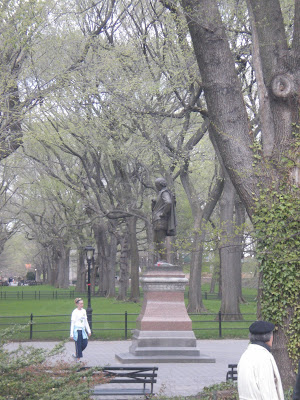
Today is April 23, the date thought to be William Shakespeare's birthday.
On or about Shakespeare's birthday in 1862, the American Shakespeare Society bestowed a birthday gift, unwittingly, on Central Park. Perhaps this was done at Shakespeare's statue and perhaps not but, on that date, 100 pairs of starlings and 100 pairs of sparrows were released into the park. It had been thought that the birds most mentioned in Shakepeare's Sonnets should be used to "decorate" the new park, just before its 1863 opening.
Preparations had been made ahead of time. Groundskeepers at London's Hyde Park were instructed to trap the 100 pairs of each of the two species. The birds were cared for on a transatlantic voyage from Southampton to New York.
A second Central Park release in 1890 or 1891 assured success for the birds. These live releases seemed like good ideas at the time.
Many, many ecological mistakes were made in the 19th century. It was a time of the absolute knowledge that Man was put on earth to master all living things. Australian settlers released rabbits, then cats, whose feral descendants play hell with native marsupial populations to this day.
Later in the century, Dutch elm trees were imported to America's eastern cities that wanted to enhance their tree-lined streets. City planters and horticulturists were unaware that Dutch elms harbored a fungal disease that kills American elms. They found out the hard way, when limbs of American elms became diseased and unable to hold up their own weight.
Groves of American elms are now few and far between. A grove of 160 American elms surrounds the Literary Walk, or The Mall, in Central Park. Most of them have lost limbs. One falling elm branch this past February killed a man who was walking underneath it as it fell! The trees are weak, and current planning doesn't call for their replacement when these mature trees begin dying off, some 40 or 50 years from now.
Ironic that the grove surrounds the statue of Shakespeare!
English sparrows and English starlings are used to humans, and flourish wherever humans go. As New York City grew after 1862, the numbers of sparrows and starlings grew with it. The problem with the birds was that they are birds: they can fly right over the walls of Central Park, to wherever they please.
And that's just what they've done. These human-tolerant birds have pushed human-intolerant native bird species out of food and nesting areas. They now dominate the park. As a matter of fact, they dominate bird life in most American cities and suburbs, and are now considered a pest species, all across North America. It's thought that the North American population of starlings is roughly 140 million, mostly in the US and Canada. They have gone west in immense flocks that can be seen from half a mile away. They steal grapes from winery vineyards in far-off California. Their ancestors were New Yorkers. THEIR ancestors were Londoners.
The other ironic thing in this story is that today is the anniversary of the first release of starlings in America. And what was yesterday? Yesterday was Earth Day.
No comments:
Post a Comment